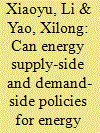| Srl | Item |
| 1 |
ID:
171511


|
|
|
|
|
| Summary/Abstract |
Existing literature mainly focuses on the combined effect of different policies on energy, economy and environment. However, most of them were based on the perspective of energy demand-side. In order to fill this gap, we study the effect of carbon tax and coal capacity cut from both the energy demand-side and energy supply-side using a dynamic Computable General Equilibrium (CGE) model. Different policy effects including single one and synergistic one are compared. Moreover, the synergy degrees of coal capacity cut and carbon tax in energy saving, emission reduction and economic growth are evaluated. The results show that both coal capacity cut and carbon tax are beneficial to energy conservation and carbon emission mitigation at the expense of a slight loss in economy. Mixed policy has better performance than single policy in carbon emission reduction and energy saving. Also, a more stringent policy is conducive to carbon emission mitigation and energy conservation. Additionally, there are significant synergistic effect of coal capacity cut and carbon tax from the perspectives of energy saving, emission reduction and economic growth. Therefore, the mixed policy of coal capacity cut and carbon tax should be promoted and an appropriate stringency level of policy mix should be adopted.
|
|
|
|
|
|
|
|
|
|
|
|
|
|
|
|
| 2 |
ID:
180115


|
|
|
|
|
| Summary/Abstract |
While the retirement of fossil fuel capacity is an inevitable consequence of the energy transition to carbon neutrality, policymakers face challenges in setting the pace in order that the energy transition policies do not significantly damage the economy. This paper designs a dynamic stochastic general equilibrium (DSGE) model to examine the macroeconomic effects of coal capacity cut policy (CCP) shocks on the Chinese economy. The results show that: firstly, an energy policy shock can distort the transmission effect of coal supply and demand and other factors on coal prices. Secondly, the impact of different policy tools is significantly different on the macroeconomic system, in which the economic effect of advanced capacity replacement is the weakest. Thirdly, in the short term, no matter which policy tool is adopted, the CCP will inevitably lead to a reduction in social welfare levels. The study suggests that in the short term, the Chinese government can further release more replacement quotas of capacity with advanced production efficiency, and innovate other policy tools for coal industrial structural optimization and synergistic effects with environmental regulation. In addition, the results highlight the need for market mechanisms to further accelerate the energy transition over the long run.
|
|
|
|
|
|
|
|
|
|
|
|
|
|
|
|